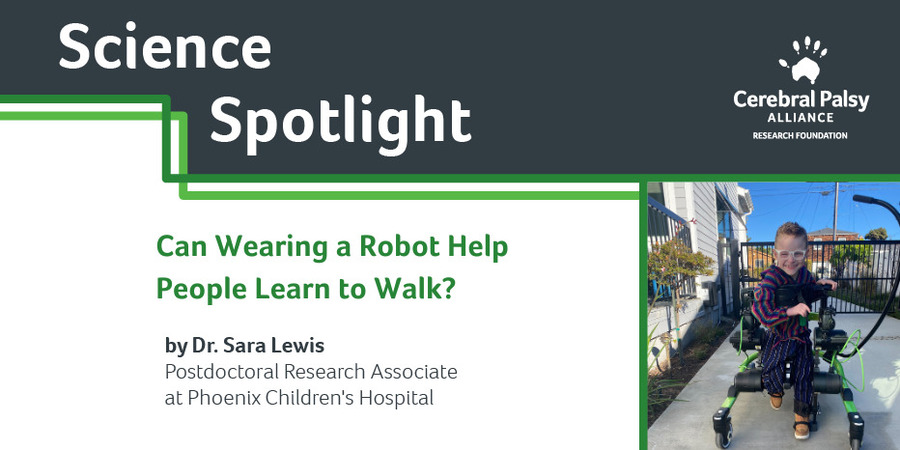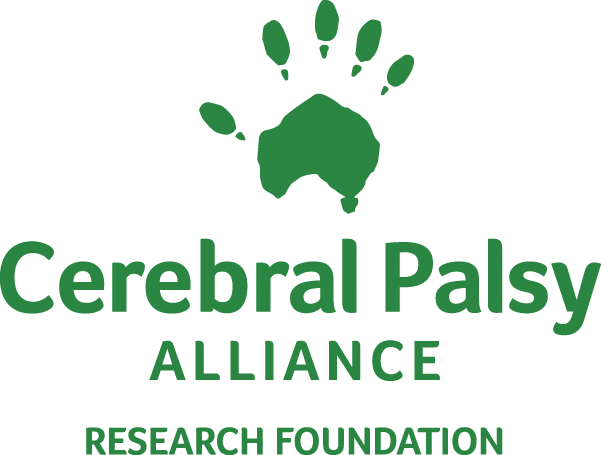
Cerebral Palsy Alliance Research Foundation proudly funds research to help people with cerebral palsy at every age and stage of life. The following Science Spotlight focuses on one of many projects we’ve recently supported.
Science Spotlight: Can Wearing a Robot Help People Learn to Walk?
By Dr. Sara Lewis
Using an exoskeleton — a robot worn over parts of the body like Ironman — can sound like something out of science fiction. But it’s reality for many people with cerebral palsy (CP). Imagine using technology to help you stand independently for the first time, walk at your graduation, or run and play with your friends. These dreams can come true in some cases, but using a worn assistive device can also have day-to-day benefits as well.
Trexo Robotics is building robotic exoskeletons that provide posture support and gait training. These are adjustable to provide the right balance of support and challenge needed to build stability and strength. A Trexo device is great for both improving the ability to participate more fully in some activities, and for improving long-term motor development. It’s also being studied in clinical trials for lessening some of the negative side effects of long-term sitting, such as improving digestion and pain.
However, the device is currently designed for children older than age two, and it is not known how early one could begin training. One of the consistent findings about physical therapy is that beginning as early as possible is key for success.
Why is early intervention so important? This is because the brain is more plastic, or able to adapt and learn new skills, during specific time windows in development. This is called a “critical period,” and during a critical period, that part of the brain is changing connections to focus on relevant information and be more efficient. These changes include increasing the strength of inhibitory connections to suppress unwanted input and pruning connections that are not useful. Whether a connection is considered useful is based on the sensory input activating synapses and neurons. In other words, use it or lose it.
Critical periods happen at different times during development for different skills. This is how we know when different developmental milestones are supposed to happen and in what order. The types of experiences a child has during a developmental period create can have lifelong effects.
For example, the critical period for the development of a binocular vision is very early, between three and eight months, with sensitivity to damage through age three. The best time to learn a second language is later, extending through puberty. Children raised in bilingual households have an easier time learning additional languages than those who have their first foreign language experience in college.
If you want to maximize the potential for development of the motor system, starting early is crucial. The movements of young children become more precise with time, as unwanted connections are pruned, patterns of neuron activity become refined, and the “right” movements are retained. If there are problems with the movements being used, this makes it harder to learn the correct movements later.
Dr. Dawn Gano at the University of California, San Fransisco, started the CPARF-supported TREx study to evaluate the feasibility and acceptability of Trexo robotic exoskeleton training in children under two years old with delayed motor skills or a CP diagnosis.
The study has two parts: the first evaluates whether the exoskeleton improves range of motion, strength and/or motor function. The second engages parents and clinicians to better understand how robotics can address the needs and goals of rehabilitation for children.
It can be challenging for very young children to use a device like the Trexo, and each patient must be fitted and require lot of external assistance to use it. The investigators worked hard to ensure there were providers and physical therapists trained on its use.
Because this is a new technology, it takes time to study how best to use it, make it more widely available and affordable, and demonstrate efficacy. Long term, studies such as TREx can be used to design a clinical trial to rigorously test exoskeleton rehabilitation compared to standard rehabilitation. This can help create more equitable access to novel technology that improves motor function and/or quality of life for children with CP.

She received her PhD in Neuroscience in 2015 with an emphasis in genetic neurodevelopmental disorders. Her work integrates human genetics with the fly model to study how genes leading to movement disorders changes in the brain.
Her work also addresses the challenges implementing genetics findings in the clinical environment. Her research is funded by CPARF.
Further information:
https://www.trexorobotics.com/
https://news.mit.edu/2018/cognitive-scientists-define-critical-period-learning-language-0501
https://www.sciencedirect.com/science/article/abs/pii/B9780444633279000011?via%3Dihub
Wed 21 May 2025
Are you ready for STEPtember 2025? We’re officially in double digits — CPARF is celebrating 10 years of funding groundbreaking cerebral palsy research and driving innovation forward. And there’s no better way to mark this milestone than with our biggest, boldest STEPtember yet. Thanks to you, STEPtember has grown into a global movement that powers […]
Thu 15 May 2025
Celebrate Your Birthday with Purpose: Start a Fundraiser That Changes Lives Birthdays are for joy, reflection, and connection — and now, they can help fund groundbreaking research, fuel innovation in assistive technology, and create lasting change for people with cerebral palsy and other disabilities. Celebrate your special day by starting a customized birthday fundraiser to […]



